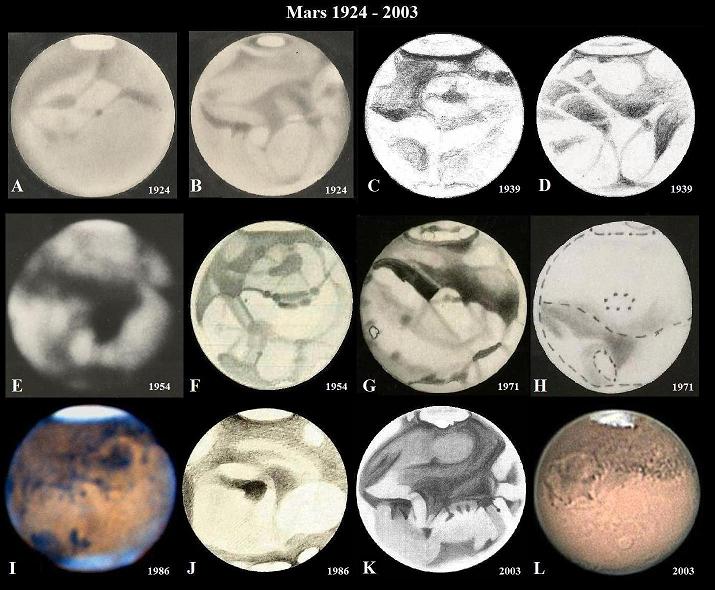Observing Mars in 2018
This will appear in the February 2018 issue of the BAA Journal
Observing Mars in 2018
Mars will be at opposition again on 2018 July 27, when its declination will be more than 25o south, the disk diameter will be 24.2 arcseconds, and the areocentric longitude Ls will equal 219o. On Mars, the last quantity corresponds to early spring in the S. hemisphere (spring having commenced at Ls = 180o), and the beginning of the season in which large dust storms can develop. Though it is a perihelic opposition (one which occurs within 90o of perihelion, Ls = 250o), UK observers will find Mars a challenging object to observe on account of the very low altitude. Consulting the BAA Handbook shows that the declination will be less unfavourable in the months prior to opposition. We shall want good coverage of the planet from early May onwards, at the very latest.
For comparison with recent perihelic oppositions, and to get a flavour of what can be observed, the writer refers readers to his final report on 2003, an opposition that was very similar in terms of presentation, and which can be found at our Section website at www.britastro/mars. A variety of maps will also be found at that website. Apart from any meteorological phenomena on display, the changing size of the S. polar cap will be of constant interest, and there will be good views of the N. polar hood as well. In the years since the last encircling storm of 2007, there has been very little change in the albedo markings, but classically variable areas such as Solis Lacus, Pandorae Fretum, Nodus Alcyonius, Aetheria and Cerberus should always be watched.
Key seasonal dates will be as follows:
Ls (o)
S. winter solstice 90 2017 Nov 19
S. spring equinox 180 2018 May 22
Opposition 219 2018 Jul 27
Perihelion 250 2018 Sep 14
S. summer solstice 270 2018 Oct 16
S. autumnal equinox 360 2019 Mar 23
The disk will be 6 arcseconds or more in diameter for the long period from 2018 mid-February until early 2019 February. Actually, the apparition actually began as long ago as last September, when some members began imaging. Their observational work will be discussed in an Interim report later.
The following past oppositions give the closest seasonal matches with 2018 (where Ls is quoted for opposition):
Year Ls (o) difference from 2018 (o)
1892 228 + 9
1907 199 – 20
1924 246 +27
1939 215 – 4
1954 188 – 31
1971 232 +13
1986 202 – 17
2003 250 +31
2018 219 0
The best match is 1939. From the above list of oppositions, those of 1924 and 1971 involved planet-encircling dust storms. No more than local or regional events occurred in the other oppositions. On average great events take place once in every third martian year.
Finally we give a few illustrations of similar perihelic oppositions (Figure 1). 1954 was one of the first oppositions for which the Mars Section received photographs; the 1986 photos [1] were able to take advantage of the then new ‘miracle film’, Kodak TP 2415, while the observers of 2003 were able to take advantage of the CCD camera and the ‘webcam revolution’. Figure 1H shows the S. hemisphere of the planet hidden under an encircling dust storm. Figures 1C, D, G, K and L show rifts and other details in the S. polar cap. Figures 1I and J show the bluish N. polar hood particularly well. Long term changes in Solis Lacus are apparent when comparing Figures 1A,C, F, I and L; likewise for Mare Sirenum by means of Figures 1G and L, etc.
Please send me your results regularly. Good observing!
Richard McKim, Director
Reference
1 More images from the writer’s stay at Pic du Midi in 1986 are now uploaded to:
http://astrosurf.com/delcroix/images/planches/astro_images.php?lang=fr&printimages=oui&o=pic&racine=m&jjmin=2446627,46319444&jjmax=2446628
[….and at my member’s page on the BAA website]

Figure 1
Drawings, photographs (E, I) and one image (L) of the perihelic oppositions of 1924-2003; all illustrations from the BAA Mars Section Archives.
(A) 1924 Aug 12d, CM= 110o, 8-in (203 mm) OG, x262, T.E.R.Phillips;
(B) 1924 Sep 27d, CM= 023o, as (A), T.E.R.Phillips;
(C) 1939 Jun 29d, CM= 082o, 203 mm refl., x213, H.M.Johnson;
(D) 1939 Jul 19d, CM= 248o, as (C), H.M.Johnson;
(E) 1954 Jul 14d, CM = 286o, 26½-in (0.67m) OG (Johannesburg), yellow filter, 25-negative composite on 16 mm Kodachrome film, W.S.Finsen;
(F) 1954 Jul 25d, CM = 074o, 200 mm refl., x400, T.Saheki;
(G) 1971 Jun 24d, CM = 174o, 260 mm refl, x400, J.Dragesco;
(H) 1971 Oct 7d, CM = 290o, 24-in (0.60 m) OG (Lowell), x830, C.F.Capen;
(I) 1986 Jul 15d, CM = 068o, 1.06 m Cass. (Pic du Midi), f/52, Kodak TP 2415 film; R(G)B composite image, lightly processed in Registax, J.Dragesco and R.J.McKim;
(J) 1986 Jul 21d, CM = 009o, 360 mm OG (Arcetri), x270, M.Falorni;
(K) 2003 Aug d, CM = 000o, 410 mm DK Cass., x410, R.J.McKim;
(L) 2003 Aug 19d, CM = 126o, 410 mm refl., f/49 RGB image with ST9XE camera, D.C.Parker.
Select here to return to the Section front page.
| The British Astronomical Association supports amateur astronomers around the UK and the rest of the world. Find out more about the BAA or join us. |
